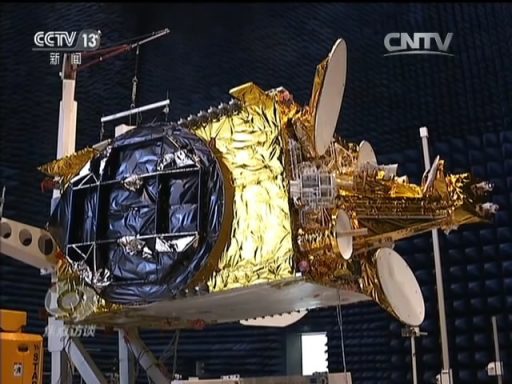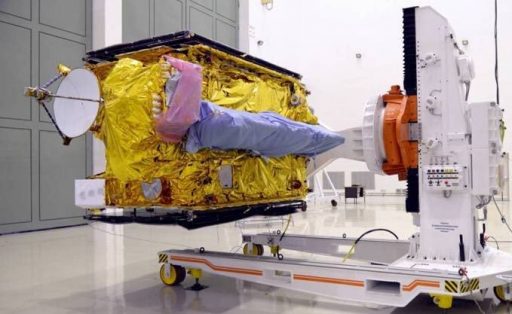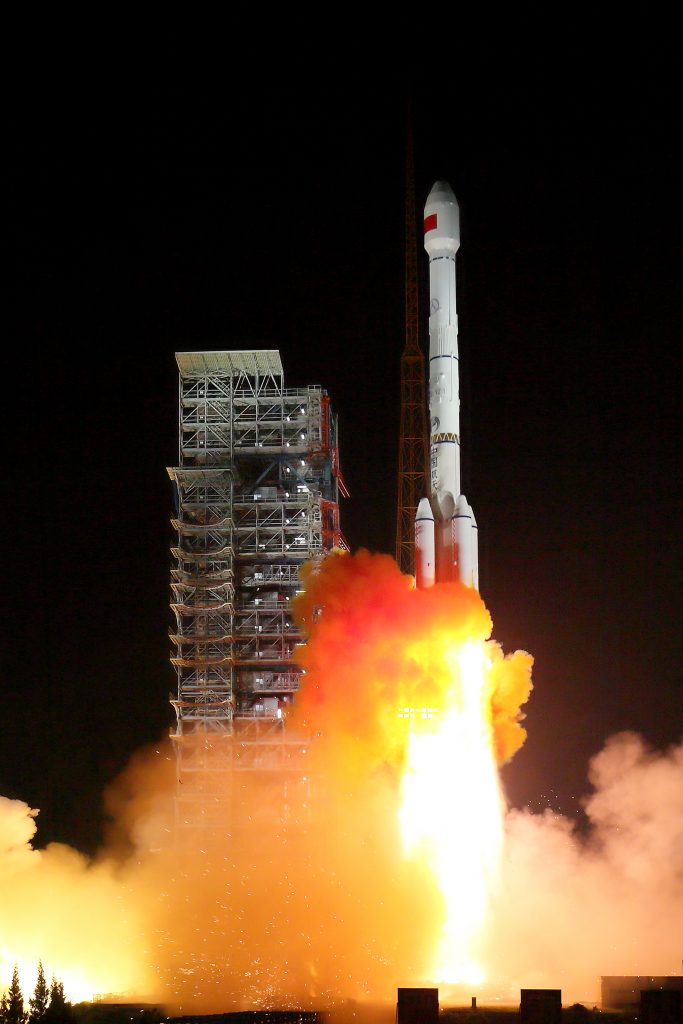Chinese Long March 3B Lifts AlcomSat-1 Dual-Purpose Communications Satellite for Algeria

China was in action again on Sunday, launching a Long March 3B rocket carrying the Chinese-built AlcomSat-1 communications satellite for operation by the Algerian Space Agency as a dual-purpose spacecraft for civilian and military communications. Long March 3B lifted off from the Xichang Satellite Launch Center at 16:40 UTC and was set for a standard Geostationary Transfer mission lasting around 25 minutes from launch to the separation of the 5,200-Kilogram satellite into a highly elliptical orbit.
Confirmation of launch success was provided by Chinese space officials after the satellite had separated from the carrier rocket.
AlcomSat-1 is Algeria’s first geostationary Communications Satellite and is operated by the country’s space agency, ASAL. The satellite will deliver a number of services for which great demand exists in Algeria including TV broadcasting, satellite Internet and mobile satellite communications while also providing capacity for use by the government and military.

The satellite and launch contracts were handled through the China Great Wall Industry Corporation that offers Chinese satellites and launch services on the commercial market.
Under the contract, the satellite was manufactured by the China Academy of Space Technology (CAST) and launched by a CZ-3B rocket provided by the China Academy of Launch Vehicle Technology (CALT). At the time of the initial contract award on September 17, 2013, AlcomSat-1 had the goal of launching in January 2016, but construction of a ground control station started only in September 2015 and pushed the launch date significantly.
AlcomSat-1 carries a hybrid communications payload for a dual mission architecture. Civilian services will be provided by Ku-Band transponders for TV broadcasting and Ka-Band for Internet distribution and mobile communications while the military-operated payload offers capacity in X-Band as well as the UHF and EHF frequency bands. Two ground stations have been built for operation of the satellite and to act as communications gateways, one in Media and the second near Ouargla. The satellite will operate for at least 15 years from an orbital position at 28.4 degrees west.

AlcomSat-1 is based on the popular DFH-4 satellite platform, representing China’s third generation communications satellite platform, capable of facilitating high-power and high-capacity communications payloads for different applications such as direct broadcasting, tracking and data relay, mobile communications, etc.
DFH-4 measures 2.36 by 2.10 by 3.60 meters in dimensions and can accommodate payloads of up to 588 Kilograms, creating a launch mass of up to 5,200 Kilograms. Two 6-meter solar arrays generate an End-of-Life power of 10,500 Watts of which 8kW are available to the payload. DFH-4 is divided into three modules – the propulsion module, the service module and the payload module. Onboard batteries are used to store power for night passes and power distribution is provided by dedicated avionics systems.
The DFH-4 satellite platform uses state of the art navigation and attitude determination systems and reaction wheel-based attitude actuation. The satellite is equipped with a main propulsion system for the climb to Geostationary Orbit and reaction control thrusters used to assist in attitude control and stationkeeping in the Geostationary Belt that is possible with an accuracy of +/-0.05° in all directions.
Sunday’s launch was China’s 16th orbital space launch of 2017, the 258th overall flight of the Long March rocket family and the fifth Long March 3B launch of the year. As is typical for the Chinese, their year in space operations is closing with roughly one launch per week with another two missions firm on the manifest to support the LKW-1 constellation inaugurated last week and the GaoJing “SuperView” Earth-imaging constellation.
>>Long March 3B Launch Vehicle

Long March 3B/E weighs approximately 456,000 Kilograms and stands 56.33 meters tall with a core diameter of 3.35 meters. The four boosters, first and second stage use storable propellants, Unsymmetrical Dimethylhydrazine and Nitrogen Tetroxide while the third stage uses cryogenic propellants, Liquid Hydrogen and Liquid Oxygen.
At 12:40 a.m. local time at Xichang, Long March 3B/E ignited its boosters and core stage that soared to a collective liftoff thrust of 604 metric-ton-force. Thundering off four seconds later, the rocket rose from its pad, lighting up the night skies over the Xichang launch base in the Sichuan province in south-western China. After a vertical ascent of a few seconds, the rocket began to pitch and roll onto its planned ascent path, taking it south-east across China before passing over the Pacific Ocean.
With all engines firing at full throttle, Long March 3B/E burned 2,350 Kilograms of propellant per second as it started racing uphill and making its way downrange. Each of the four boosters delivered 75,500 Kilogram-force of additional thrust to the vehicle using a single DaFY-5-1 engine, consuming 41 metric tons over the course of a burn of 140 seconds after which the boosters dropped away from the three-stage rocket.
With the boosters gone, the Core Stage was to continue powering the vehicle using a DaFY-6-1 cluster of four engines delivering 302 metric tons of thrust. Overall, the 24.8-meter tall first stage launched with a propellant load of 186,200 Kilograms that was to be expended in two minutes and 38 seconds. Immediately after engine cutoff on the first stage, the second stage was to command its four-chamber vernier engine to ignite as part of the hot-staging sequence employed by the Long March 3B.

A series of 14 pyrotechnic bolts were to fire to disconnect the first and second stage, allowing the second stage’s vernier engine to move the stack away from the empty core stage. Moments after staging, the second stage was to ignite its DaFY-20-1 main engine, soaring up to a full thrust of 75,660 Kilogram-force to continue powered ascent. Overall, the second stage launched with a propellant load of 49,400 Kilograms, measuring 12.92 meters in length and 3.35 meters in diameter.
While the second stage was firing, Long March 3B was to depart the dense atmosphere, making it safe to jettison the protective payload fairing and expose the AlcomSat-1 satellite for the rest of its ride uphill.
The second stage was to fire for 178 seconds with the vernier engine burning about six seconds longer than the main engine and separation from the third stage occurring via pyrotechnics and solid-fueled retrorockets.
One second after staging, the third stage was to ignite its two cryogenic YF-75 engines. The 12.38-meter long third stage delivers a total thrust of 16,000 Kilogram-force as part of its initial burn to accelerate the stack to orbital velocity in order to enter a Low Earth Parking Orbit.
The Low Earth Parking orbit, around 190 Kilometers in altitude, was to be reached after a third stage burn of around four minutes and 45 seconds, marking the start of a coast phase. The coast phase, nearly 11 minutes in duration, was set up to allow the stack to fly to a position where the second burn could be performed around the equator passage so that the high-point of the orbit would be placed over the equator.
This second burn, approximately three minutes and 15 seconds in duration, was to be followed by a variable velocity adjustment by the vernier engines of the third stage which were to fire until the navigation platform sensed that the target injection velocity was achieved, thus optimizing the accuracy of the orbital insertion with spacecraft separation taking place approximately 26 minutes after liftoff.

